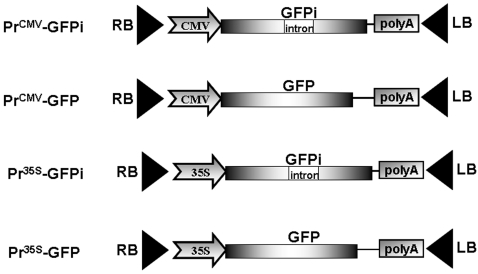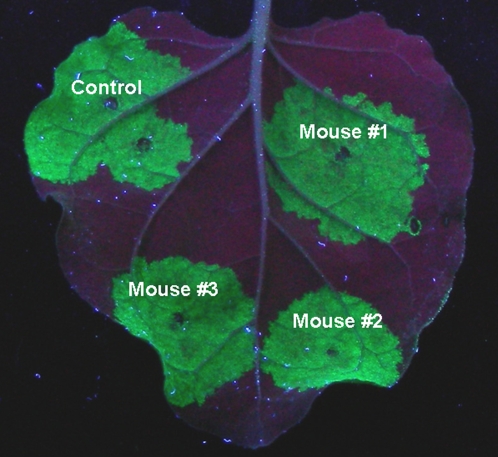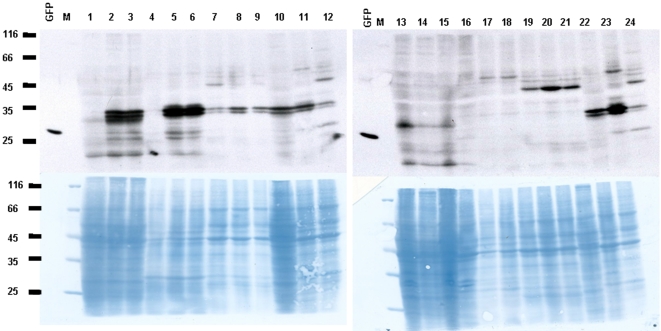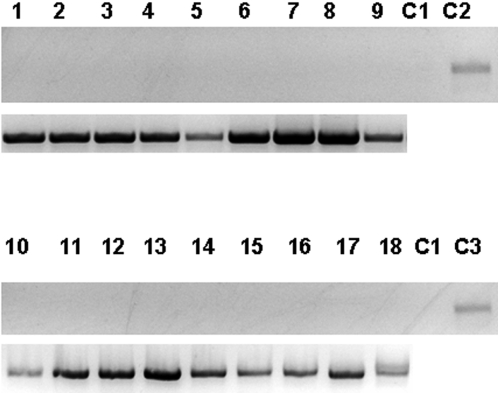Abstract
Agrobacterium tumefaciens is the main plant biotechnology gene transfer tool with host range which can be extended to non-plant eukaryotic organisms under laboratory conditions. Known medical cases of Agrobacterium species isolation from bloodstream infections necessitate the assessment of biosafety-related risks of A. tumefaciens encounters with mammalian organisms. Here, we studied the survival of A. tumefaciens in bloodstream of mice injected with bacterial cultures. Bacterial titers of 108 CFU were detected in the blood of the injected animals up to two weeks after intravenous injection. Agrobacteria carrying Cauliflower mosaic virus (CaMV) 35S promoter-based constructs and isolated from the injected mice retained their capacity to promote green fluorescent protein (GFP) synthesis in Nicotiana benthamiana leaves. To examine whether or not the injected agrobacteria are able to express in mouse organs, we used an intron-containing GFP (GFPi) reporter driven either by a cytomegalovirus (CMV) promoter or by a CaMV 35S promoter. Western and northern blot analyses as well as RT-PCR analysis of liver, spleen and lung of mice injected with A. tumefaciens detected neither GFP protein nor its transcripts. Thus, bacteraemia induced in mice by A. tumefaciens does not lead to detectible levels of genetic transformation of mouse organs.
Introduction
Genetically engineered plants often represent a preferred source of recombinant proteins and biopharmaceuticals for human consumption [1], [2]. In modern plant biotechnology, genetic transformation of plants is usually achieved using Agrobacterium tumefaciens. This bacterium is a soil-borne, nonpathogenic for humans microorganism which can transfer its T-DNA into the genomes not only of plants but also of human cultured cells (for review, see [3]–[5]). Wide exploitation of Agrobacterium for biotechnological purposes and numerous medical cases of Agrobacterium species isolation from bloodstream infections [6]–[17] require the assessment of biosafety-related implications of Agrobacterium invasion of mammalian organisms.
We studied whether or not intravenously injected A .tumefaciens can survive in mouse bloodstream and direct expression of its T-DNA within mouse organs. Our data indicate that, although Agrobacterium persisted in the bloodstream for up to two weeks post injection, it failed to express the reporter GFP gene in such diverse organs as spleen, liver and lung. Thus, Agrobacterium induces bacteremia in mice, but does not cause detectible genetic alteration of mouse tissues.
Results and Discussion
To examine whether agrobacteria can express the reporter gene both in animal and plant cells, we created binary constructs in which GFP expression is driven by either the cytomegalovirus (CMV) or CaMV 35S promoters (Fig. 1). We also inserted a small synthetic intron sequence into the GFP open reading frame (GFPi) to avoid intra-bacterial GFP synthesis due to potentially leaky promoter activity.
Figure 1. GFP-encoding constructs for intravenous mouse agroinjection.
Schematic representation of the cytomegalovirus (CMV) promoter- and CaMV 35S promoter-driven green fluorescent protein cDNA without (GFP) or with an intron sequence (GFPi). All constructs were based on the T-DNA of the pBin19 binary vector. LB and RB indicate the left and right T-DNA borders, respectively. Poly A indicates the CaMV 35S- or CMV-specific transcriptional terminators.
Agrobacteria carrying these reporter constructs were first characterized for their viability in blood vessel system. To this end, freshly growing A. tumefaciens GV3101 (108 CFU) was administered into mouse by tail vein injection, and blood samples were plated on an antibiotic-containing LB agar medium. Table 1 shows that Agrobacterium remained viable in the bloodstream during at least 6 days after injection. A few blood samples yielded bacterial colonies even two weeks after injection (data not shown). Agrobacteria contained within the blood samples retained not only the capacity to growth on antibiotic-containing media, but also directed expression of the GFP gene from the CaMV 35S promoter in leaves Nicotiana benthamiana (Fig. 2).
Table 1. A. tumefaciens surviving in mice.
| Mouse number | Time after agroinjection | Colony-forming units | |
| per plate | average | ||
| 1 | 1h | 88 | 89.0 |
| 90 | |||
| 2 | 92 | 131.0 | |
| 170 | |||
| 3 | 250 | 158.5 | |
| 67 | |||
| 4 | 90 | 82.5 | |
| 75 | |||
| 5 | 100 | 67.5 | |
| 35 | |||
| 1 | 24h | 9 | 8.0 |
| 7 | |||
| 2 | 12 | 8.5 | |
| 5 | |||
| 3 | 15 | 10.5 | |
| 6 | |||
| 4 | 4 | 3.5 | |
| 3 | |||
| 5 | 35 | 23.5 | |
| 12 | |||
| 1 | 48h | 23 | 17.0 |
| 11 | |||
| 2 | 51 | 44.0 | |
| 37 | |||
| 3 | 96 | 59.0 | |
| 23 | |||
| 4 | 15 | 50.0 | |
| 85 | |||
| 5 | 150 | 99.0 | |
| 48 | |||
| 1 | 72h | 3 | 8.5 |
| 14 | |||
| 2 | 4 | 4.0 | |
| 4 | |||
| 3 | 7 | 5.0 | |
| 3 | |||
| 4 | 4 | 8.0 | |
| 12 | |||
| 5 | 17 | 18.5 | |
| 20 | |||
| 1 | 96h | 11 | 47.0 |
| 83 | |||
| 2 | 5 | 16.5 | |
| 28 | |||
| 3 | 43 | 43.5 | |
| 44 | |||
| 4 | 27 | 22.5 | |
| 18 | |||
| 5 | 30 | 33.5 | |
| 37 | |||
| 1 | 144h | 11 | 32.0 |
| 53 | |||
| 2 | 112 | 74.0 | |
| 36 | |||
| 3 | 170 | 148.5 | |
| 27 | |||
| 4 | 28 | 23.5 | |
| 19 | |||
| 5 | 37 | 26.0 | |
| 15 | |||
Figure 2. Agrobacteria recovered from the injected mice direct GFP expression in plant cells.
GFP accumulation in leaf sectors co-injected with agrobacteria carrying the CaMV 35S promoter-based binary construct and isolated from mouse blood was determined 3 dpi. Control, agrobacteria used for mouse injection.
Next, we studied the expression of the intron-containing GFPi gene in HeLa cells. On Western blots (Fig. 3), the GFP antibody labeled a 31-kDa band in samples transfected either with CMV-directed GFPi or with CMV promoter-directed GFP (lanes 1, 2). The 27-kDa GFP expressed in mammalian cells is known to assume folding that corresponds to an apparent electrophoretic mobility of a 31 kDa protein [18], [19]. This GFP-specific signal was not observed in samples transfected with CaMV 35S promoter-based constructs (Fig. 3, lanes 3, 4). Thus, mammalian cells promoted the correct splicing of the Petunia hybrida intron sequence.
Figure 3. GFP detection in HeLa cells transfected with CMV promoter-based (lanes 1, 2) and CaMV 35S promoter-based (lanes 3,4) constructs encoding GFP (lanes 1 ,3) or GFPi (lanes 2, 4).
M, protein molecular weight markers.
Interestingly, our western blot analyses of proteins from different organs of mice injected with bacteria carrying the CMV promoter-drive reporter construct did not revealed 27–31 kDa GFP-specific products, although some protein samples, including those from control, uninjected mice exhibited non-specific cross-reactivity of anti-GFP antibodies with a 35-kDa double-band (Fig. 4). Consistently, northern blot hybridization (Fig. 5) and RT-PCR analysis (Fig. 6) of RNA isolated from different organs of agroinjected mice did not detect any GFP-specific transcripts. These observations indicate that A. tumefaciens can persist in the bloodstream of agroinjected mice for relatively long periods of time, but they are unable to cause detectible levels of genetic transformation of mouse organs.
Figure 4. Western blot analysis of protein extracts from different organs of mice injected with agrobacteria.
Liver (lanes 1–3, 10, 13–15) after injection with agrobacteria containing the CMV promoter-based vectors encoding GFPi (lanes 1–3, corresponding to mice #1–3) or GFP (lane 10), or an empty vector (lanes 13–15, corresponding to mice #5–7); Spleen (lanes 4–6, 11, 16–18) after injection with agrobacteria containing the CMV promoter-based vectors encoding GFPi (lanes 4–6, corresponding to mice #1–3) or GFP (lane 11), or an empty vector (lanes 16–18, corresponding to mice #5–7); Lung (lanes 7–9,12,19–21) after injection with agrobacteria containing the CMV promoter-based vectors encoding GFPi (lanes 7–9, corresponding to mice #1–3) or GFP (lane 12), or an empty vector (lanes 19–21, corresponding to mice #5–7). Control (lanes 22–24)–liver (lane 22), spleen (lane 23) and lung (lane 24) of an intact mouse. GFP–bacterially expressed 27-kDa GFP (2 ng) as a positive control.
Figure 5. Northern blot analysis of RNA isolated from HeLa cells and mice livers.
HeLa cells were transfected with CMV promoter-based (lanes 1, 2) and CaMV 35S promoter-based constructs (lanes 3, 4) encoding GFPi. Mice #1–3 (lanes 6–8) were injected with agrobacteia harboring the CMV promoter-based constructs encoding GFPi. Mouse injected with agrobacteria harboring an empty binary vector (lane 5). Top panel, GFP-specific transcripts; bottom panel, 28S rRNA used as a loading control.
Figure 6. RT-PCR analysis of RNA isolated from liver (lanes 1–3, 10–12), spleen (lanes 4–6, 13–15) and pulmonary (lanes 7–9, 16–18) tissues of mouse injected with agrobacteria harboring CMV promoter-based binary constructs with the GFP (lanes 1–9) or GFPi gene (lanes 10–18).
C1, control 1–RNA isolated from a mouse injected with agrobacteria carrying an empty vector; C2, C3 controls 2 and 3–RNA isolated from HeLa cells transfected with the CMV-based constructs containing the GFP or GFPi gene, respectively. Top panel, GFP-specific RT-PCR products; bottom panel, actin-specific RT-PCR products used as a loading control.
That A. tumefaciens and related species can infect mammals, including humans, is supported by numerous medical literature [6]–[17]. However, it should be noted that virtually all the reported cases of such infection occur in immunologically compromised patients who often also have suffered a loss of body integrity, such as invasive surgery, catheter insertion, or a major wound, which presumably allow bacterial access to the bloodstream or internal tissues. Thus, most likely, in healthy individuals, the immune system successfully copes with A. tumefaciens which persists in most of our natural environment, e.g., soil, plant roots, etc. Furthermore, that Agrobacterium strains isolated from infected patients often do not contain the Ti plasmid or its elements required for genetic transformation [6]–[17] suggests that (i) the genetic determinants of this opportunistic infectivity likely reside in the bacterial chromosome, rather than in the Ti plasmid, and (ii) unlike infection of plants, infection of mammals by Agrobacterium does not necessitate genetic alteration of the host. This idea is consistent with our observations that A. tumefaciens can persist in the mouse bloodstream without detectible expression of its T-DNA in the host tissues as well as with previous findings that A. tumefaciens genetically transforms cultured mammalian cells inefficiently [20], probably at the levels undetectable in whole animal tissues. Interestingly, embryonic tissues may be more susceptible to transformation which has been recently reported for sea urchin embryos [21].
Materials and Methods
Plasmids used for agroinjection
The CaMV 35S promoter-based plasmid encoding GFP was described earlier [22]. A. tumefaciens containing in its T-DNA the GFP gene with Petunia hybrida PSK7 gene 74-nt intron-7 sequence (GFPi) was kindly provided by Dr. Y. Gleba. For construction of the CMV promoter-based vectors, GFP or GFPi cDNA was inserted into the pcDNA3.1 plasmid digested with XhoI and HindIII. The resulting plasmids were digested with MfeI and SphI, filled-in with the Klenow enzyme and ligated into the binary vector pCAMBIA1300 after its digestion with XhoI and HindIII and filling-in with Klenow.
Agroinjection procedure
A. tumefaciens strain GV3101 was transformed with individual binary constructs, grown in LB medium supplemented with rifampicin 50 mg/l at 28°C. Agrobacterium cells from an overnight culture (2 ml) were collected by centrifugation (10 min, 4,500×g), resuspended in saline and adjusted to a final OD600 of 0.2. The resulting bacterial suspensions were administered into each recipient naive BALB/c mouse intravenously through the tail vein. For determination of bacterial titers, blood samples (50 µl) from tail vein of mice were added into a tube (950 µl) with heparin (6 units/ml) containing LB growth medium and RGK antibiotic mixture [rifampicin (50 µg/ml), gentamicin (25 µg/ml), kanamycin (100 µg/ml)]. A sample (250 µl) of this mixture was plated on an LB-RGK agar medium, and the bacterial titer was calculated as number of colony forming units (CFU).
Human cell transfection
HEK293 (human embryonic kidney) cells were plated on 35-mm Petri dishes. For transfection, 2 µg of plasmid DNA and 3 µl of Unifectin56™ (Unifect, Russia) were added to each dish in according to the manufacturer's protocol. GFP fluorescence was detected 24 hours after transfection. Forty eight hours post transfection, cells were trypsinized (HyClone Trypsin), washed with 1× phosphate-buffered saline (PBS) and resuspended in PBS. Then, equal volume of 2× loading buffer (60% glycerol, 5 mM β-mercaptoethanol, 10% SDS, 250 mM Tris-HCl pH 6.8) was added to the cell suspension, and extracts were boiled for 5 min and subjected to electrophoresis on 12% SDS/polyacrylamide gels.
RNA isolation and Northern blot analysis
Isolation of total RNA was performed using TRI-REAGENT (Molecular Research Center, Inc) using the manufacturer's protocol. Northern blot analysis was performed as described earlier [23].
Reverse Transcription-Polymerase Chain Reaction (RT-PCR) analysis
RT of extracted RNA was performed using the first-strand cDNA synthesis kit (Promega) according to the manufacturer's instructions. First-strand GFP and actin cDNAs were synthesized using 0.5 µg of RNA and primers GFP-M (5′TTACTTGTACAGCTCGTCCATGCCGAGA3′) and Act-M (5′AGGGTACATGGTGGTGCCGCCAGAC3′), respectively. The cDNAs were then amplified by PCR using primers GFP-P (5′ATGGTGAGCAAGGGCGAGGAGCTGTTC3′) and Act-P (5′CCAAGGCCAACCGCGAGAAGATGAC3′), respectively. PCR was carried out in a programmable Tercik thermocycler (DNA technology, Russia) with the following conditions: 94°C for 10 minutes followed by 30 cycles, each comprising denaturation for 1 minute at 94°C; annealing for 1 minute at 58°C for GFP or 60°C for actin; and then extension for 1 minute at 72°C. After completion of PCR, reaction tubes were kept for 5 minutes at 72°C and then stored at 4°C until use. Negative controls routinely used for each set of primers included reactions without template. Samples were analyzed on 1.5% agarose gels.
Western blot analysis
The proteins from mouse organs (spleen, liver, lung) were isolated using TRI-REAGENT (Molecular Research Center, Inc) according to the manufacturer's protocol and analyzed by western blotting with GFP-specific antibodies as described earlier [23].
Acknowledgments
We thank Dr. Y. Y. Gleba (Icon Genetics GmbH) for generously providing the strain of A. tumefaciens with GFPi construct. We also thank Dr. B. Goodner for his invaluable suggestions to improve the manuscript.
Footnotes
Competing Interests: The authors have declared that no competing interests exist.
Funding: This work was partly supported by Russian Foundation for Basic Research (grant 06-08-01473). The work in the VC laboratory is supported by grants from NIH, NSF, NRI USDA CSREE, BARD, BSF, and CDR-USAID.
References
- 1.Giddings G, Allison G, Brooks D, Carter A. Transgenic plants as factories for biopharmaceuticals. Nat Biotechnol. 2000;18:1151–1155. doi: 10.1038/81132. [DOI] [PubMed] [Google Scholar]
- 2.Newell CA. Plant transformation technology. Developments and applications. Mol Biotechnol. 2000;16:53–65. doi: 10.1385/MB:16:1:53. [DOI] [PubMed] [Google Scholar]
- 3.McCullen CA, Binns AN. Agrobacterium tumefaciens and plant cell interactions and activities required for interkingdom macromolecular transfer. Annu Rev Cell Dev Biol. 2006;22:101–127. doi: 10.1146/annurev.cellbio.22.011105.102022. [DOI] [PubMed] [Google Scholar]
- 4.Lacroix B, Tzfira T, Vainstein A, Citovsky V. A case of promiscuity: Agrobacterium's endless hunt for new partners. Trends Genet. 2006;22:29–37. doi: 10.1016/j.tig.2005.10.004. [DOI] [PubMed] [Google Scholar]
- 5.Tzfira T, Citovsky V. Agrobacterium-mediated genetic transformation of plants: biology and biotechnology. Curr Opin Biotechnol. 2006;17:1–8. doi: 10.1016/j.copbio.2006.01.009. [DOI] [PubMed] [Google Scholar]
- 6.Edmond MB, Riddler SA, Baxter CM, et al. Agrobacterium radiobacter: a recently recognized opportunistic pathogen. Clin Infect Dis. 1993;16:388–391. doi: 10.1093/clind/16.3.388. [DOI] [PubMed] [Google Scholar]
- 7.Hulse M, Johnson S, Ferrieri P. Agrobacterium infections in humans: experience at one hospital and review. Clin Infect Dis. 1993;16:112–117. doi: 10.1093/clinids/16.1.112. [DOI] [PubMed] [Google Scholar]
- 8.Alnor D, Frimodt-Moller N, Espersen F, et al. Infections with the unusual human pathogens Agrobacterium species and Ochrobactrum anthropi. Clin Infect Dis. 1994;18:914–920. doi: 10.1093/clinids/18.6.914. [DOI] [PubMed] [Google Scholar]
- 9.Swann RA, Foulkes SJ, Holmes B, et al. ‘Agrobacterium yellow group’ and Pseudomonas paucimobilis causing peritonitis in patients receiving continuous ambulatory peritoneal dialysis. J Clin Pathol. 1985;38:1293–1299. doi: 10.1136/jcp.38.11.1293. [DOI] [PMC free article] [PubMed] [Google Scholar]
- 10.Amaya RA, Edwards MS. Agrobacterium radiobacter bacteremia in pediatric patients: case report and review. Pediatr Infect Dis J. 2003;22:183–186. doi: 10.1097/01.inf.0000048960.37470.ef. [DOI] [PubMed] [Google Scholar]
- 11.Christakis GB, Alexaki P, Alivizatos AS, Chalkiopoulou I, Athanasiou AE, et al. Primary bacteraemia caused by Rhizobium radiobacter in a patient with solid tumours. J Med Microbiol. 2006;55:1453–1456. doi: 10.1099/jmm.0.46411-0. [DOI] [PubMed] [Google Scholar]
- 12.Chalandon Y, Roscoe DL, Nantel SH. Agrobacterium yellow group: bacteremia and possible septic arthritis following peripheral blood stem cell transplantation. Bone Marrow Transplant. 2000;26:101–104. doi: 10.1038/sj.bmt.1702470. [DOI] [PubMed] [Google Scholar]
- 13.Giammanco GM, Pignato S, Santangelo C, Grimont PA, Grimont F, et al. Molecular typing of Agrobacterium species isolates from catheter-related bloodstream infections. Infect Control Hosp Epidemiol. 2004;25:885–887. doi: 10.1086/502315. [DOI] [PubMed] [Google Scholar]
- 14.Manfredi R, Nanetti A, Ferri M, Mastroianni A, Coronado OV, et al. Emerging gram-negative pathogens in the immunocompromised host: Agrobacterium radiobacter septicemia during HIV disease. New Microbiol. 1999;22:375–382. [PubMed] [Google Scholar]
- 15.Paphitou NI, Rolston KV. Catheter-related bacteremia caused by Agrobacterium radiobacter in a cancer patient: case report and literature review. Infection. 2003;31:421–424. doi: 10.1007/s15010-003-3175-5. [DOI] [PubMed] [Google Scholar]
- 16.Peiris K, Gee TM, Boswell TC. Bloodstream infection related to heparin infusion caused by Agrobacterium tumefaciens. J Hosp Infect. 2006;62:250–251. doi: 10.1016/j.jhin.2005.06.022. [DOI] [PubMed] [Google Scholar]
- 17.Siegman-Igra Y, Jacobi E, Lang R, Schwartz D, Carmeli Y. Unexpected hospital-acquired bacteraemia in patients at low risk of bloodstream infection: the role of a heparin drip. J Hosp Infect. 2005;60:122–128. doi: 10.1016/j.jhin.2004.11.021. [DOI] [PubMed] [Google Scholar]
- 18.Klein RL, Hamby ME, Gong Y, Hirko AC, Wong S, et al. Dose and promoter effects of adeno-associated viral vector for green fluorescent protein expression in the rat brain. Exp Neurol. 2002;176:66–74. doi: 10.1006/exnr.2002.7942. [DOI] [PubMed] [Google Scholar]
- 19.Sacchetti A, Cappetti V, Marra P, Dell'Arciprete R, El Sewedy T, et al. Green fluorescent protein variants fold differentially in prokaryotic and eukaryotic cells. J Cell Biochem Suppl. 2001;36:117–128. doi: 10.1002/jcb.1091. [DOI] [PubMed] [Google Scholar]
- 20.Kunik T, Tzfira T, Kapulnik Y, Gafni Y, Dingwall C, Citovsky V. Genetic transformation of HeLa cells by Agrobacterium. Proc Natl Acad Sci USA. 2001;98:1871–1876. doi: 10.1073/pnas.041327598. [DOI] [PMC free article] [PubMed] [Google Scholar]
- 21.Bulgakov VP, Kiselev KV, Yakovlev KV, Zhuravlev YN, Gontcharov AA, Odintsova NA. Agrobacterium-mediated transformation of sea urchin embryos. Biotechnol J. 2006;1:454–461. doi: 10.1002/biot.200500045. [DOI] [PubMed] [Google Scholar]
- 22.Dorokhov YL, Frolova OY, Skurat EV, Ivanov PA, Gasanova TV, et al. A novel function for a ubiquitous plant enzyme pectin methylesterase: the enhancer of RNA silencing. FEBS Lett. 2006;580:3872–3878. doi: 10.1016/j.febslet.2006.06.013. [DOI] [PubMed] [Google Scholar]
- 23.Dorokhov YL, Ivanov PA, Komarova TV, Skulachev MV, Atabekov JG. An internal ribosome entry site located upstream of the crTMV coat protein (CP) gene can be used for CP synthesis in vivo. . J Gen Virol. 2006;87:2693–2697. doi: 10.1099/vir.0.82095-0. [DOI] [PubMed] [Google Scholar]








